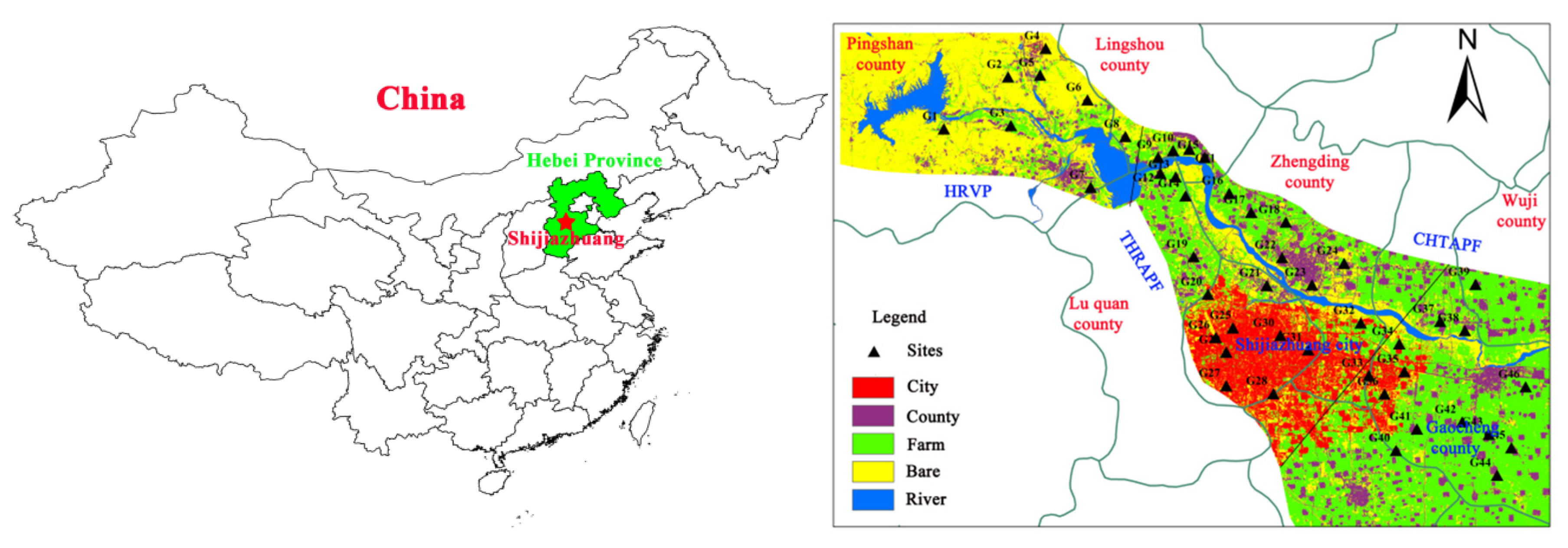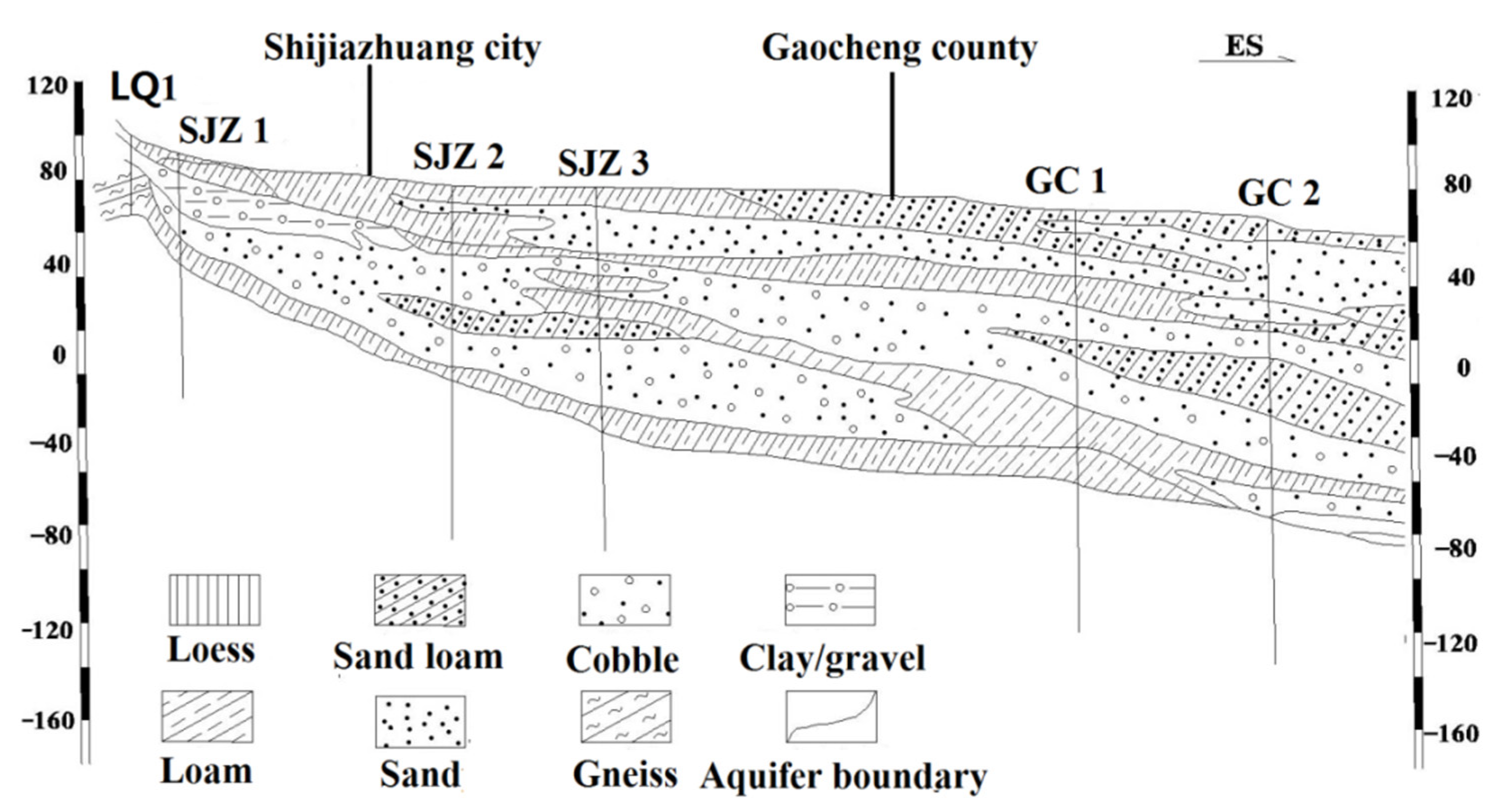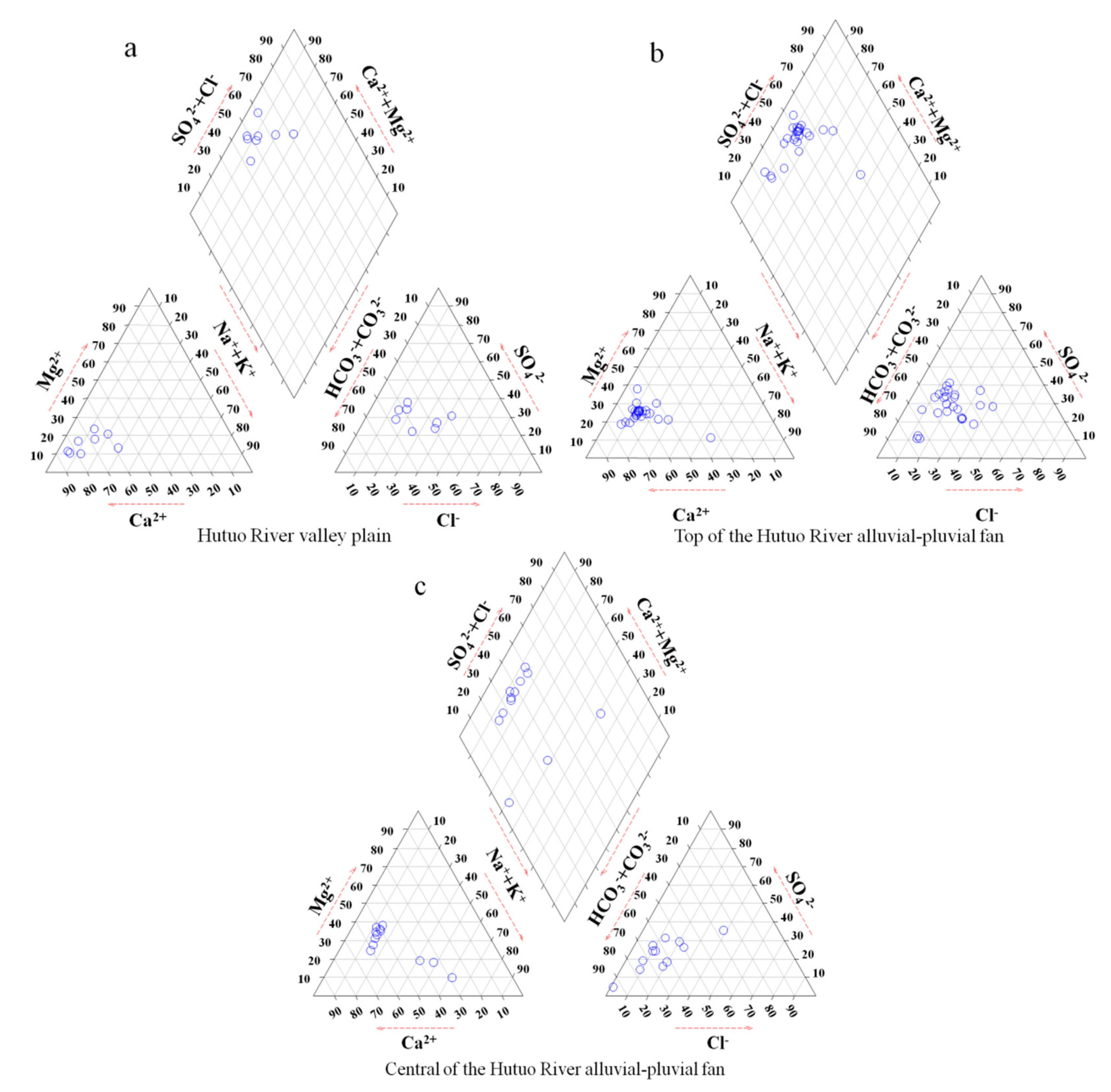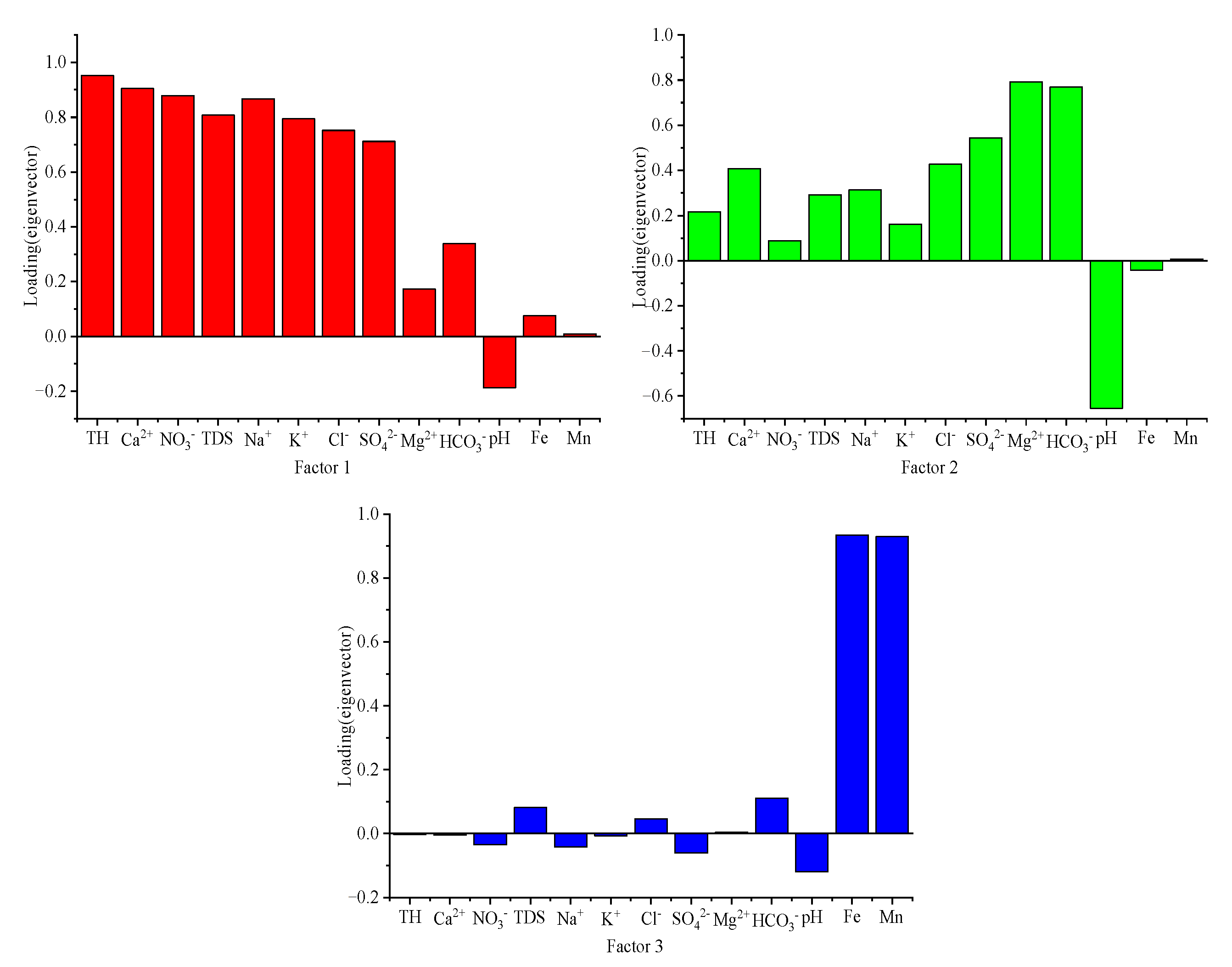Groundwater Chemical Characteristics and Controlling Factors in a Region of Northern China with Intensive Human Activity
Abstract
1. Introduction
2. Materials and Methods
2.1. Study Area
2.2. Groundwater Sampling and Laboratory Analyses
2.3. Data Analysis
2.4. Multivariate Data Analysis
Contrast Coefficient Variance
3. Results
3.1. Main Ionic Characteristics
3.2. Hydrochemical Type
3.3. Analysis of Hydrochemistry
4. Discussion
4.1. Groundwater Chemical Characteristics in a Region with Intensive Human Activity
4.2. Analysis of Major Ion Sources
4.2.1. Correlation Analysis
4.2.2. Source Judgment by Using Contrast Coefficient Variance
4.3. Controlling Factors of Groundwater Chemical
5. Managerial Implications and Future Research
6. Conclusions
Author Contributions
Funding
Conflicts of Interest
References
- Zhang, Q.; Wang, H.; Wang, Y.; Yang, M.; Zhu, L. Groundwater quality assessment and pollution source apportionment in an intensely exploited region of northern China. Environ. Sci. Pollut. Res. 2017, 24, 16639. [Google Scholar] [CrossRef]
- Jiang, Y.; Wu, Y.; Groves, C.; Yuan, D.; Kambesis, P. Natural and anthropogenic factors affecting the groundwater quality in the Nandong karst underground river system in Yunan, China. J. Contam. Hydrol. 2009, 109, 49. [Google Scholar] [CrossRef]
- Qin, R.; Wu, Y.; Xu, Z.; Xie, D.; Zhang, C. Assessing the impact of natural and anthropogenic activities on groundwater quality in coastal alluvial aquifers of the lower Liaohe River Plain, NE China. Appl. Geochem. 2013, 31, 142. [Google Scholar] [CrossRef]
- Xue, D.; Botte, J.; Baets, B.D.; Accoe, F.; Nestler, A.; Taylor, P.; Cleemput, O.V.; Berglund, M.; Boeckx, P. Present limitations and future prospects of stable isotope methods for nitrate source identification in surface- and groundwater. Water Res. 2009, 43, 1159. [Google Scholar] [CrossRef]
- Moore, W.S. The subterranean estuary: A reaction zone of ground water and sea water. Mar. Chem. 1999, 65, 111–125. [Google Scholar] [CrossRef]
- Tziritis, E.; Skordas, K.; Kelepertsis, A. The use of hydrogeochemical analyses and multivariate statistics for the characterization of groundwater resources in a complex aquifer system. A case study in Amyros River basin, Thessaly, central Greece. Environ. Earth Sci. 2016, 75, 339. [Google Scholar] [CrossRef]
- Pazand, K.; Khosravi, D.; Ghaderi, M.R.; Rezvanianzadeh, M.R. Identification of the hydrogeochemical processes and assessment of groundwater in a semi-arid region using major ion chemistry: A case study of Ardestan basin in Central Iran. Groundw. Sustain. Dev. 2018, 6, 245–254. [Google Scholar] [CrossRef]
- Huang, G.; Sun, J.; Zhang, Y.; Chen, Z.; Liu, F. Impact of anthropogenic and natural processes on the evolution of groundwater chemistry in a rapidly urbanized coastal area, South China. Sci. Total Environ. 2013, 463, 209. [Google Scholar] [CrossRef] [PubMed]
- Lin, C.Y.; Abdullah, M.H.; Praveena, S.M.; Yahaya, A.H.B.; Musta, B. Delineation of temporal variability and governing factors influencing the spatial variability of shallow groundwater chemistry in a tropical sedimentary island. J. Hydrol. 2012, 432, 26. [Google Scholar] [CrossRef]
- Li, X.; Tang, C.; Cao, Y.; Li, D. A multiple isotope (H, O, N, C and S) approach to elucidate the hydrochemical evolution of shallow groundwater in a rapidly urbanized area of the Pearl River Delta, China. Sci. Total Environ. 2020, 724, 137930. [Google Scholar] [CrossRef]
- Güler, C.; Kurt, M.A.; Alpaslan, M.; Akbulut, C. Assessment of the impact of anthropogenic activities on the groundwater hydrology and chemistry in Tarsus coastal plain (Mersin, SE Turkey) using fuzzy clustering, multivariate statistics and GIS techniques. J. Hydrol. 2012, 414–415, 435–451. [Google Scholar]
- Li, Z.; Yang, Q.; Yang, Y.; Ma, H.; Wang, H.; Luo, J.; Bian, J.; Martin, J.D. Isotopic and geochemical interpretation of groundwater under the influences of anthropogenic activities. J. Hydrol. 2019, 576, 685–697. [Google Scholar] [CrossRef]
- Gu, H.; Chi, B.; Li, H.; Jiang, J.; Qin, W.; He, W. Assessment of groundwater quality and identification of contaminant sources of Liujiang basin in Qinhuangdao, North China. Environ. Earth Sci. 2015, 73, 6477. [Google Scholar] [CrossRef]
- Boateng, T.K.; Opoku, F.; Acquaah, S.O.; Akoto, O. Groundwater quality assessment using statistical approach and water quality index in Ejisu-Juaben Municipality, Ghana. Environ. Earth Sci. 2016, 75, 489. [Google Scholar] [CrossRef]
- Herojeet, R.; Rishi, M.S.; Lata, R.; Sharma, R. Application of environmetrics statistical models and water quality index for groundwater quality characterization of alluvial aquifer of Nalagarh Valley, Himachal Pradesh, India. Sustain. Water Resour. Manag. 2016, 2, 39. [Google Scholar] [CrossRef]
- Gholizadeh, M.H.; Melesse, A.M.; Reddi, L. Water quality assessment and apportionment of pollution sources using APCS-MLR and PMF receptor modeling techniques in three major rivers of South Florida. Sci. Total Environ. 2016, 566–567, 1552. [Google Scholar] [CrossRef] [PubMed]
- Zhang, Q.; Wang, X.; Wan, W.; Hou, P.; Li, R.; Ouyang, Z. The Spatial-Temporal Pattern and Source Apportionment of Water Pollution in a Trans-Urban River. Pol. J. Environ. Stud. 2015, 24, 841. [Google Scholar]
- Zhang, Q.Q.; Wang, H.W.; Lu, C. Tracing sulfate origin and transformation in an area with multiple sources of pollution in northern China by using environmental isotopes and Bayesian isotope mixing model. Environ. Pollut. 2020, 265, 115105. [Google Scholar] [CrossRef]
- Foster, S.; Garduno, H.; Evans, R.; Olson, D.; Tian, Y.; Zhang, W.; Han, Z. Quaternary aquifer of the north china plain—Assessing and achieving groundwater resource sustainability. Hydrogeol. J. 2004, 12, 81–93. [Google Scholar] [CrossRef]
- Li, Y.; Zhang, Z.; Fei, Y.; Chen, H.; Qian, Y.; Yu, D. Investigation of quality and pollution characteristics of groundwater in the Hutuo River Alluvial Plain, North China Plain. Environ. Earth Sci. 2016, 75, 581. [Google Scholar] [CrossRef]
- Ministry of Natural Resources of the People’s Republic of China. Standard for Groundwater Quality, (GB/T14848-2017); General Administration of Quality Supervision, Inspection and Quarantine of the People’s Republic of China: Beijing, China, 2017. (In Chinese)
- Li, P.; Wu, J.; Qian, H. Assessment of groundwater quality for irrigation purposes and identification of hydrogeochemical evolution mechanisms in Pengyang County, China. Environ. Earth Sci. 2013, 69, 2211. [Google Scholar] [CrossRef]
- Tang, J.P.; Zhang, Q.; Hu, Y. Groundwater chemical characteristics and analysis of their controlling factors in an alluvial fan of Jianjiang River. Environ. Sci. 2019, 40, 3089. (In Chinese) [Google Scholar]
- Zhang, Q.; Miao, L.; Wang, H.; Hou, J.; Li, Y. How Rapid Urbanization Drives Deteriorating Groundwater Quality in a Provincial Capital of China. Pol. J. Environ. Stud. 2020, 29, 441. [Google Scholar] [CrossRef]
- Zhang, Q.; Wang, H. Assessment of sources and transformation of nitrate in the alluvial-pluvial fan region of north China using a multi-isotope approach. J. Environ. Sci. 2020, 89, 9. [Google Scholar] [CrossRef] [PubMed]
- Meghdadi, A.; Javar, N. Quantification of spatial and seasonal variations in the proportional contribution of nitrate sources using a multi-isotope approach and Bayesian isotope mixing model. Environ. Pollut. 2018, 235, 207. [Google Scholar] [CrossRef] [PubMed]
- Zhang, F.E.; Huang, G.X.; Hou, Q.X.; Liu, C.Y.; Zhang, Y.; Zhang, Q. Groundwater quality in the Pearl River Delta after the rapid expansion of industrialization and urbanization: Distributions, main impact indicators, and driving forces. J. Hydrol. 2019, 577, 124004. [Google Scholar] [CrossRef]
- González Pérez, D.M.; Martín Martín, J.M.; Guaita Martínez, J.M.; Sáez-Fernández, F.J. An Analysis of the Cost of Water Supply Linked to the Tourism Industry. An Application to the Case of the Island of Ibiza in Spain. Water 2020, 12, 2006. [Google Scholar] [CrossRef]
- Egbi, C.D.; Anornu, G.A.; Ganyaglo, S.Y.; Appiah-Adjei, E.K.; Li, S.L.; Dampare, S.B. Nitrate contamination of groundwater in the Lower Volta River Basin of Ghana: Sources and related human health risks. Ecotoxicol. Environ. Saf. 2020, 191, 110227. [Google Scholar] [CrossRef]
- Ma, M.D.C.; Esteller, M.V.; Exposito, J.L.; Hirata, R. Impacts of urbanization on groundwater hydrodynamics and hydrochemistry of the Toluca Valley aquifer (Mexico). Environ. Monit. Assess. 2014, 186, 2979. [Google Scholar]
- Busico, G.; Kazakis, N.; Colombani, N.; Mastrocicco, M.; Voudouris, K.; Tedesco, D. A modified SINTACS method for groundwater vulnerability and pollution risk assessment in highly anthropized regions based on NO3− and SO42− concentrations. Sci. Total Environ. 2017, 609, 1512–1523. [Google Scholar] [CrossRef] [PubMed]
- Meng, F.A.; Liang, X.J.; Hao, Y.; Wang, Y.H.; Lou, Y.; Li, H.W. Dynamic Characteristics of Groundwater in Taoer River Fan. Water Sav. Irrig. 2016, 4, 65. (In Chinese) [Google Scholar]
- Liu, C.Q.; Li, S.L.; Lang, Y.C.; Xiao, H.Y. Using delta15N- and delta18O-values to identify nitrate sources in karst ground water, Guiyang, southwest China. Environ. Sci. Technol. 2006, 40, 6928. [Google Scholar] [CrossRef] [PubMed]
- Jin, Z.; Xue, Q.; Chen, L.; Jin, M.; Li, F. Using dual isotopes to evaluate sources and transformations of nitrate in the West Lake watershed, eastern China. J. Contam. Hydrol. 2015, 177, 64. [Google Scholar] [CrossRef] [PubMed]
- Bohlke, J.K. Groundwater recharge and agricultural contamination. Hydrogeol. J. 2002, 10, 153. [Google Scholar] [CrossRef]
- Chen, J.; Tang, C.; Sakura, Y.; Yu, J.; Fukushima, Y. Nitrate pollution from agriculture in different hydrogeological zones of the regional groundwater flow system in the North China Plain. Hydrogeol. J. 2005, 13, 481. [Google Scholar] [CrossRef]
- Bu, H.; Tan, X.; Li, S.; Zhang, Q. Temporal and spatial variations of water quality in the Jinshui River of the South Qinling Mts., China. Ecotoxicol. Environ. Saf. 2010, 73, 907. [Google Scholar] [CrossRef]
- Juahir, H.; Zain, S.M.; Yusoff, M.K.; Hanidza, T.T.; Armi, A.M.; Toriman, M.E.; Mokhtar, M. Spatial water quality assessment of Langat River Basin (Malaysia) using environmetric techniques. Environ. Monit. Assess. 2011, 173, 625. [Google Scholar] [CrossRef]
- Nestler, A.; Berglund, M.; Accoe, F.; Duta, S.; Xue, D.; Boeckx, P.; Taylor, P. Isotopes for improved management of nitrate pollution in aqueous resources: Review of surface water field studies. Environ. Sci. Pollut. Res. 2011, 18, 519–533. [Google Scholar] [CrossRef]
- Past en-Zapata, E.; Ledesma-Ruiz, R.; Harter, T.; Ramı´rez, A.I.; Mahlknecht, J. Assessment of sources and fate of nitrate in shallow groundwater of an agricultural area by using a multi-tracer approach. Sci. Total Environ. 2014, 470–471, 855–864. [Google Scholar] [CrossRef]
- Guo, Z.F.; Yan, C.Z.; Wang, Z.S.; Xu, F.F.; Yang, F. Quantitative identification of nitrate sources in a coastal peri-urban watershed using hydrogeochemical indicators and dual isotopes together with the statistical approaches. Chemosphere 2020, 243, 125364. [Google Scholar] [CrossRef]
- Torres-Martínez, J.A.; Mora, A.; Knappett, P.S.K.; Ornelas-Soto, N.; Mahlknecht, J. Tracking nitrate and sulfate sources in groundwater of an urbanized valley using a multi-tracer approach combined with a Bayesian isotope mixing model. Water Res. 2020, 182, 115962. [Google Scholar] [CrossRef] [PubMed]





| Parameters | pH | TDS | K+ | Na+ | Ca2+ | Mg2+ | HCO3− | Cl− | SO42− | NO3− | NO2− | Fe | Mn | TH | |
|---|---|---|---|---|---|---|---|---|---|---|---|---|---|---|---|
| (I) Hutuo River valley plain unit (n = 8) | Min | 7.64 | 500.7 | 0.6 | 10.1 | 135.2 | 10.23 | 187.0 | 51.09 | 62.4 | 68.8 | 0.002 | 0.017 | 0.001 | 379.8 |
| Max | 7.88 | 1913 | 22.0 | 180.8 | 345.4 | 53.1 | 381.4 | 322.4 | 322.3 | 465.0 | 0.007 | 0.552 | 0.012 | 1058 | |
| Mean | 7.73 | 950.4 | 5.80 | 50.9 | 211.7 | 29.7 | 315.7 | 121.5 | 176.7 | 176.2 | 0.003 | 0.148 | 0.004 | 650.6 | |
| SD | 0.08 | 455.6 | 7.66 | 56.1 | 68.3 | 15.8 | 70.0 | 99.3 | 78.7 | 139.7 | 0.002 | 0.180 | 0.004 | 219.7 | |
| Exceed standard rate (%) | 0 | 25 | — | 0 | — | — | — | 12.5 | 12.5 | 62.5 | 0 | 12.5 | 0 | 87.5 | |
| (II) Top of the Hutuo River pluvial fan (n = 26) | Min | 7.42 | 241 | 0.27 | 9.08 | 53.5 | 11.7 | 171.7 | 15.9 | 21.8 | 5.04 | 0.002 | 0.010 | 0.001 | 182.2 |
| Max | 8.40 | 1508 | 7.05 | 307.2 | 224.1 | 79.1 | 429.3 | 343.5 | 318.2 | 216.0 | 0.041 | 0.324 | 0.013 | 814.2 | |
| Mean | 7.80 | 720.4 | 2.00 | 47.3 | 143.8 | 36.0 | 311.7 | 89.9 | 151.4 | 75.8 | 0.005 | 0.067 | 0.003 | 507.3 | |
| SD | 0.22 | 280.7 | 1.26 | 58.0 | 41.6 | 14.6 | 68.8 | 72.6 | 74.9 | 45.0 | 0.009 | 0.084 | 0.004 | 157.7 | |
| Exceed standard rate (%) | 0 | 11.5 | — | 3.8 | — | — | — | 3.8 | 3.8 | 34.6 | 0 | 3.8 | 0 | 73.1 | |
| (III) Center of the Hutuo River pluvial fan (n = 12) | Min | 7.38 | 152.2 | 1.26 | 17.7 | 20.6 | 5.95 | 141.0 | 1.06 | 5.27 | 1.76 | 0.002 | 0.010 | 0.001 | 76.1 |
| Max | 7.97 | 626.5 | 2.56 | 139 | 110.1 | 41.5 | 334.2 | 135.3 | 168.6 | 21.8 | 0.004 | 1.313 | 0.040 | 445.9 | |
| Mean | 7.63 | 412.8 | 2.13 | 36.5 | 69.8 | 25.2 | 249.3 | 42.6 | 81.4 | 9.10 | 0.002 | 0.214 | 0.005 | 278.0 | |
| SD | 0.18 | 124.9 | 0.50 | 37.1 | 22.3 | 10.8 | 56.13 | 35.0 | 45.3 | 7.35 | 0.001 | 0.399 | 0.011 | 96.0 | |
| Exceed standard rate (%) | 0 | 0 | — | 0 | — | — | — | 0 | 0 | 0 | 0 | 8.3 | 0 | 0 | |
| Standard | 6.5–8.5 | 1000 | — | 200 | — | — | — | 250 | 250 | 88.6 | 3.29 | 0.3 | 0.1 | 450 | |
| Parameters | pH | TDS | K+ | Na+ | Ca2+ | Mg2+ | Cl− | SO42− | HCO3− | NO3− | Fe | Mn | TH |
|---|---|---|---|---|---|---|---|---|---|---|---|---|---|
| pH | 1.000 | ||||||||||||
| TDS | −0.079 | 1.000 | |||||||||||
| K+ | −0.066 | 0.215 | 1.000 | ||||||||||
| Na+ | −0.088 | 0.687 ** | 0.320 * | 1.000 | |||||||||
| Ca2+ | −0.067 | 0.917 ** | 0.060 | 0.439 ** | 1.000 | ||||||||
| Mg2+ | −0.177 | 0.752 ** | 0.196 | 0.540 ** | 0.648 ** | 1.000 | |||||||
| Cl− | −0.108 | 0.863 ** | 0.170 | 0.706 ** | 0.741 ** | 0.598 ** | 1.000 | ||||||
| SO42− | 0.015 | 0.826 ** | 0.231 | 0.709 ** | 0.746 ** | 0.634 ** | 0.681 ** | 1.000 | |||||
| HCO3− | −0.165 | 0.823 ** | 0.257 | 0.656 ** | 0.742 ** | 0.808 ** | 0.631 ** | 0.670 ** | 1.000 | ||||
| NO3− | 0.043 | 0.868 ** | 0.222 | 0.370 * | 0.909 ** | 0.585 ** | 0.683 ** | 0.649 ** | 0.645 ** | 1.000 | |||
| Fe | 0.148 | 0.080 | 0.111 | 0.051 | 0.076 | 0.067 | 0.063 | −0.006 | 0.127 | 0.030 | 1.000 | ||
| Mn | 0.091 | 0.032 | 0.205 | −0.018 | 0.048 | −0.012 | −0.018 | −0.007 | 0.157 | 0.029 | 0.737 ** | 1.000 | |
| TH | −0.098 | 0.956 ** | 0.130 | 0.519 ** | 0.964 ** | 0.803 ** | 0.770 ** | 0.756 ** | 0.820 ** | 0.889 ** | 0.083 | 0.040 | 1.000 |
| Parameters | HRVP | THRAPF | CHRAPF |
|---|---|---|---|
| pH | 0.000 | 0.001 | 0.001 |
| TH | 0.114 | 0.097 | 0.119 |
| TDS | 0.230 | 0.152 | 0.092 |
| K+ | 1.744 | 0.397 | 0.056 |
| Na+ | 1.216 | 1.503 | 1.033 |
| Ca2+ | 0.104 | 0.084 | 0.102 |
| Mg2+ | 0.285 | 0.165 | 0.183 |
| Cl− | 0.668 | 0.653 | 0.675 |
| SO42− | 0.199 | 0.245 | 0.310 |
| HCO3− | 0.049 | 0.049 | 0.051 |
| NO3− | 0.629 | 0.353 | 0.652 |
| Fe | 1.474 | 1.562 | 3.480 |
| Mn | 1.011 | 1.541 | 0.292 |
Publisher’s Note: MDPI stays neutral with regard to jurisdictional claims in published maps and institutional affiliations. |
© 2020 by the authors. Licensee MDPI, Basel, Switzerland. This article is an open access article distributed under the terms and conditions of the Creative Commons Attribution (CC BY) license (http://creativecommons.org/licenses/by/4.0/).
Share and Cite
Ren, C.; Zhang, Q. Groundwater Chemical Characteristics and Controlling Factors in a Region of Northern China with Intensive Human Activity. Int. J. Environ. Res. Public Health 2020, 17, 9126. https://doi.org/10.3390/ijerph17239126
Ren C, Zhang Q. Groundwater Chemical Characteristics and Controlling Factors in a Region of Northern China with Intensive Human Activity. International Journal of Environmental Research and Public Health. 2020; 17(23):9126. https://doi.org/10.3390/ijerph17239126
Chicago/Turabian StyleRen, Chaobin, and Qianqian Zhang. 2020. "Groundwater Chemical Characteristics and Controlling Factors in a Region of Northern China with Intensive Human Activity" International Journal of Environmental Research and Public Health 17, no. 23: 9126. https://doi.org/10.3390/ijerph17239126
APA StyleRen, C., & Zhang, Q. (2020). Groundwater Chemical Characteristics and Controlling Factors in a Region of Northern China with Intensive Human Activity. International Journal of Environmental Research and Public Health, 17(23), 9126. https://doi.org/10.3390/ijerph17239126




